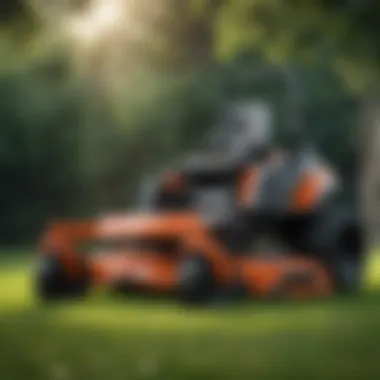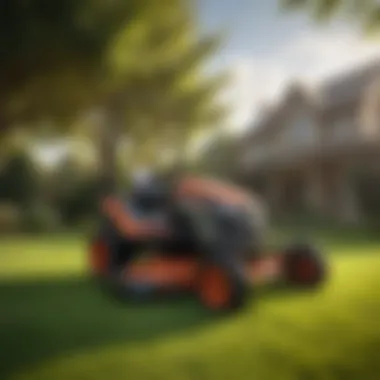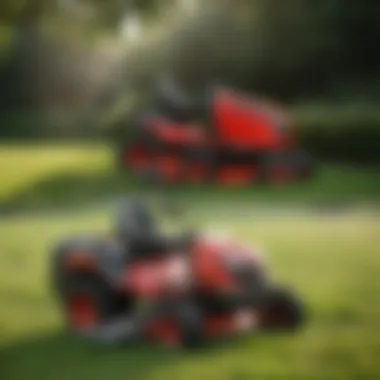Essential Guide to Choosing a Zero Turn Mower


Intro
Choosing a zero turn mower is not just a simple task; it is a crucial decision that can impact the efficiency of your lawn care. For those entrenched in agricultural or horticultural pursuits, the right mower can make a significant difference in productivity and the quality of work. This guide aims to provide detailed insights into key factors that influence the selection of a zero turn mower, ensuring users can make an informed choice suited to their specific needs.
Key Insights
Overview of the Topic
A zero turn mower is known for its agility and speed. The design allows for maximum maneuverability, which is especially important when navigating around obstacles like trees, flower beds, or garden equipment. Unlike traditional mowers, zero turn models can turn on a dime. This capability often enhances the productivity of lawn maintenance tasks, which is appealing to both amateur gardeners and professional landscapers.
Importance in Agriculture/Horticulture/Agronomy
The role of zero turn mowers in agriculture and horticulture cannot be underestimated. They provide efficiency in maintaining large areas of grass or crops. In commercial settings, such as golf courses or public parks, these mowers are essential for maintaining aesthetic appeal and plant health. The design also reduces the possibility of damaging young plants when mowing, as the precision control allows for closer cutting around delicate vegetation.
"A well-functioning mower not only increases productivity but also minimizes maintenance costs in the long run."
Sustainable Practices
Eco-Friendly Techniques
Selecting a zero turn mower can also be influenced by sustainable practices. Mowers that utilize electric power rather than gasoline contribute to reduced carbon emissions. Additionally, some models have features that optimize grass clipping management, allowing for healthier lawns by recycling clippings instead of bagging them.
Case Studies on Sustainability
In agricultural settings, some farms have adopted practices like using zero turn mowers equipped with mulching capabilities. This process helps in returning nutrients back to the soil, fostering a healthier ecosystem. Farms that practice integrated pest management have also noted better results when combining mowing operations with strategic planting and turf management techniques.
Tools & Resources
Essential Equipment and Technologies
When considering the purchase of a zero turn mower, having the right tools and equipment is essential. The following points should be considered:
- Engine Power: The horsepower of the engine should match the size of the area to be mowed.
- Cutting Width: A larger cutting width reduces mowing time but requires more maneuverability.
- Deck Material: A strong deck can handle rugged terrains and reduce maintenance.
Recommended Books and Readings
For a more in-depth understanding of mowers and landscaping practices, the following resources may be valuable:
- The Complete Manual of Woodworking - A useful read for understanding tools associated with landscape maintenance.
- Landscaping Principles and Practices - Offers insights into various methods of maintaining landscape efficiently.
Understanding Zero Turn Mowers
Understanding zero turn mowers is crucial for anyone interested in optimizing their lawn care and mowing experience. This type of mower is designed with a unique mechanism allowing it to pivot on its own axis, providing superior maneuverability. Unlike traditional lawn mowers, which have a fixed turning radius, zero turn mowers offer the flexibility to navigate tight spaces effectively. This characteristic is particularly beneficial for properties with complex landscaping or numerous obstacles.
Definition and Mechanism
A zero turn mower is defined by its ability to turn without needing to swing the rear of the machine, making it significantly more agile than conventional mowers. The mowing mechanism typically consists of two independent drive wheels, each controlled by separate levers. This allows the operator to steer the mower precisely, achieving sharper turns and making it possible to mow around trees, flower beds, and other landscape features. The design also generally incorporates a larger cutting deck, which facilitates faster mowing of larger areas.
In essence, the key feature of a zero turn mower is its rear-wheel drive system. By controlling the speed of each wheel independently, operators can execute complex maneuvers that would be challenging with a standard mower. This versatility translates into less time spent mowing and a cleaner cut in tighter areas, which is a significant advantage for both commercial landscapers and residential users.
Comparison with Traditional Lawn Mowers
Comparing zero turn mowers to traditional lawn mowers reveals several distinct differences that impact user experience. Traditional mowers, such as riding mowers or push mowers, typically exhibit a wider turning radius. This limitation often leads to uncut patches and necessitates additional passes to cover all areas effectively. Moreover, maneuverability is compromised when dealing with obstacles, which can require intricate navigation or lead to frustrating mowing challenges.
On the other hand, zero turn mowers, with their agile control systems, allow for seamless navigation through tight spots. This agility increases efficiency, particularly in complex landscapes. Additionally, zero turn mowers often have higher speeds, allowing for quicker completion of mowing tasks.
"A zero turn mower can reduce mowing time by up to 50%, depending on the complexity of the lawn layout."
The tradeoff to consider is that zero turn mowers tend to be heavier than traditional mowers and may not perform as well on uneven terrain. Understanding these dynamics helps potential buyers assess whether a zero turn mower is the right fit considering their specific lawn care needs.
Ultimately, grasping the fundamental differences and functionalities of zero turn mowers versus traditional mowers sets the stage for making an informed purchasing decision. Knowing how these machines operate can lead to enhanced effectiveness in lawn maintenance.
Assessing Your Lawn Size and Terrain
When considering a zero turn mower, understanding the specific features of your lawn is crucial. The various characteristics of your lawn, including its size and terrain, directly influence not only the type of mower you should choose but also the efficiency and effectiveness of your mowing. Assessing these elements accurately allows you to make a more informed decision, ensuring that you select a mower suited to your particular requirements. A seamless mowing experience begins with a clear picture of your lawn's demands.


Determining Mower Size
The size of your lawn is a fundamental factor in choosing a zero turn mower. Mowers come in various sizes, and each size corresponds to a different mowing capacity. Larger lawns may benefit from mowers with a bigger cutting deck, enabling them to cover more ground with fewer passes. For instance, if you have two acres or more, a mower with a 54-inch or larger deck is generally recommended.
On the other hand, if your lawn is smaller than one acre, a mower with a smaller cutting width may be more manageable and suited to your needs. A smaller mower offers enhanced maneuverability in tight spaces, which is essential for intricate landscaping.
In summary, assessing the overall size of your lawn will guide you toward a mower size that optimizes your mowing time and minimizes the effort required.
Evaluating Terrain Types
Different terrains require different considerations. It is important to evaluate the nature of your lawn’s surface. Is it flat, hilly, or does it contain slopes and dips? For flat lawns, a standard zero turn mower will generally perform well. However, if your terrain includes inclines or uneven ground, you will need a mower specifically designed to handle these challenges.
Zero turn mowers that offer a low center of gravity work better on hilly terrain as they provide greater stability. Additionally, mower engines with higher torque can effectively manage incline gradients, ensuring a powerful and controlled mowing experience.
Consider any obstacles within the landscape as well. Trees, flowerbeds, or garden borders can significantly affect maneuverability.
Technical Specifications
Understanding the technical specifications of a zero turn mower is essential for making an informed purchase. They encompass a range of elements that directly influence the machine's performance, efficiency, and suitability for different types of mowing tasks. In particular, the specifications should be aligned with your specific requirements, ensuring that the mower meets not only your immediate needs but also any future demands you may encounter.
Engine Power and Performance
The heart of any mower is its engine. When selecting a zero turn mower, engine power can determine how effectively the mower can tackle different mowing conditions. Generally, engines are measured in horsepower (HP), and higher horsepower often translates to better performance, particularly in dense or overgrown grass. A robust engine enhances cutting efficiency, reduces time spent on mowing, and can even improve fuel economy in some models. It is crucial to consider the engine's displacement as well, as this can affect torque and overall performance.
Factors to evaluate include:
- Fuel Type: Most zero turn mowers run on gasoline, but some electric models are now available.
- Single vs. Twin Cylinder Engines: Twin-cylinder engines tend to offer smoother operation and higher torque, which is beneficial for larger lawns.
- Cooling System: An effective cooling system can prevent engine overheating during prolonged use.
Cutting Deck Options
The cutting deck is another vital specification that directly affects mowing quality and efficiency. Zero turn mowers come with different cutting deck sizes, commonly ranging from 32 inches to over 60 inches. The size influences the width of the swath you can cut in a single pass. A wider deck allows for quicker mowing but might hinder maneuverability in tight spaces. Understanding the necessary cutting deck is essential for your specific lawn size and shape.
Additionally, consider the following:
- Deck Material: Steel decks are robust and offer durability, while plastic or composite materials might be lighter but less sturdy.
- Deck Height Adjustment: Look for mowers with easy height adjustment options, so you can adapt to different grass lengths.
Speed Capabilities
Speed is often overseen but is crucial for operational efficiency. Some zero turn mowers can reach speeds up to 10 mph, significantly reducing mowing time for large areas. It is important to understand that high-speed capabilities should not compromise cutting quality. A mower that excels in speed but lacks the capacity to cut cleanly may require more passes, negating any efficiency gains.
Consider:
- Forward and Reverse Speeds: Look for specifications that detail both forward and reverse speeds to ensure you can navigate efficiently.
- Throttle Control: Mowers with intuitive throttle control allow users to adjust speeds to suit different mowing tasks.
"Choosing the right technical specifications can make a world of difference in your mowing experience, translating to efficiency, comfort, and satisfaction."
When evaluating technical specifications, take your time to compare models. This careful consideration can ensure that you find a mower optimized for your unique needs.
Maneuverability and Control
Maneuverability and control are fundamental aspects when selecting a zero turn mower. These features significantly influence how well the mower performs in various landscaping tasks. With considerations for both effectiveness and efficiency, understanding these elements is paramount for achieving optimal mowing outcomes.
Steering System Considerations
The steering system in a zero turn mower can greatly affect its maneuverability. Most zero turn mowers use a dual lever steering system, which allows for precise control. This design enables the user to navigate around obstacles with ease. A good steering system should be responsive and intuitive. Any lag in response might lead to tedious mowing experiences. Additionally, the steering levers should be adjustable in height to accommodate different user preferences and physical attributes.
When testing potential mowers, pay attention to how the steering feels. It helps to test-drive several models to gauge comfort levels. This experience can reveal the machine's sensitivity to abrupt movements. For optimal performance, ensure the levers are easy to reach and manipulate from the seat, as this minimizes the effort needed during prolonged use.
Turning Radius and Agility
The turning radius is a vital factor that directly impacts the mower’s agility. Zero turn mowers are designed to turn within their own footprint. This feature is advantageous for navigating tight spots, such as flower beds and around trees. A tighter turning radius facilitates quicker mowing without extensive track backing, making it ideal for residential and commercial properties with complex landscaping.
It is essential to consider how well the mower handles on inclines and uneven terrain. A mower with good agility can maintain traction even when making sharp turns. Users should scrutinize the specifications that detail the turning radius, aiming for models that offer smaller radii for better functionality.
Comfort Features
When selecting a zero turn mower, comfort features are crucial. Users often spend hours mowing, so the right ergonomic design can affect productivity and satisfaction. The following aspects emphasize comfort:


- Seat Quality
- Vibration Dampening
These elements have significant impacts on the user's experience, especially for those with large lawns or challenging terrains.
Seat Quality and Ergonomics
The seat of a zero turn mower plays a pivotal role in user comfort. A quality seat should have enough padding and support to reduce fatigue over extended periods. It should also be adjustable to cater to different body sizes and preferences.
Furthermore, ergonomic design helps in promoting natural posture while mowing. This reduces strain on the back, neck, and shoulders. Many modern mowers offer high-back seats, which provide better support and more comfort.
Investing in a zero turn mower with a good seat can mean the difference between an enjoyable mowing session and an uncomfortable, frustrating one. Notably, consider the adjustment options available, as this contributes to personal comfort.
Vibration Dampening Technology
Vibration dampening technology is another essential comfort feature. Prolonged exposure to vibrations can lead to discomfort or even health issues over time.
Many manufacturers integrate systems that absorb or minimize vibrations. This ensures that the user experiences a smoother ride while mowing. The technology not only enhances comfort but may also improve control and precision, reducing fatigue during longer tasks.
"Incorporating vibration dampening technology in a zero turn mower can significantly enhance overall user satisfaction, particularly in rough terrains."
When evaluating mowers, ask about the specific dampening systems used. This can help determine how well the machine will perform under different conditions and how much comfort it provides.
Making informed choices about comfort features can improve mowing experience significantly. A comfortable mower is not only easier to use but also encourages regular upkeep of lawns and gardens.
Maintenance Requirements
Maintaining a zero turn mower is essential for ensuring optimal performance and longevity. Regular maintenance not only helps avoid costly repairs but also improves efficiency and safety during operation. The intricate mechanisms in these mowers necessitate attention, as neglect can lead to premature wear or functional issues. Proper maintenance practices maximize the mower's productivity, making it a crucial aspect in the decision-making process for both professionals and hobbyists.
Oil Changes and Maintenance Practices
Oil changes are one of the most vital aspects of maintaining a zero turn mower. Regular oil changes prevent engine damage and enhance performance. The frequency of oil changes depends on the manufacturer’s guidelines and your usage. Typically, it is recommended to change oil every 50 to 100 hours of operation or at least once a season.
Apart from oil, checking and replacing the oil filter during these changes is important. A clean filter ensures the engine receives sufficient lubrication, reducing wear over time. This simple task can greatly extend the life of the mower and improve its efficiency.
Other maintenance practices include:
- Checking air filters: Clean air filters improve engine performance and fuel efficiency.
- Sharpening blades: Dull blades can tear grass, leading to a poor cut and stress on the mower. Sharpen blades regularly, ideally after 20-25 hours of use.
- Inspecting belts and cables: Look for signs of wear and fraying on belts and cables. Replacing them when necessary ensures smooth operation.
- Cleaning the mower deck: Removing grass clippings and debris not only improves performance but also prevents rust.
These maintenance practices can save time and costs in the long run. Keeping a maintenance schedule helps ensure no crucial tasks are overlooked.
Availability of Spare Parts
When selecting a zero turn mower, considering the availability of spare parts is critical. Unlike other machinery, zero turn mowers often have specific components that may not be found everywhere. Ease of access to spare parts minimizes downtime in case of repairs or part replacements.
Check if the manufacturer has a good reputation for providing replacement parts. Reliable brands often maintain a substantial inventory of parts to meet customer needs. Additionally, verify if local dealers have stock on common part failures, such as belts, blades, and filters.
Furthermore, some online retailers offer parts for a variety of brands. Look for companies that specialize in mower parts, offering competitive pricing and shipping options.
Budget Considerations
Budget considerations play a pivotal role in the decision-making process when selecting a zero turn mower. Understanding your budget helps narrow down your choices and allows you to assess the potential value of the mower against its cost. It also ensures that you are investing in a machine that meets your operational needs without stretching your financial limits. Evaluating your budget entails not only looking at the initial purchase price but also factoring in the long-term costs. This comprehensive view aids in making a balanced decision that aligns with your financial goals.
Initial Purchase Price
The initial purchase price of a zero turn mower is often the first factor that buyers consider. This price can vary significantly based on brand, size, and features. Budget-friendly options may be available, but these models could lack essential capabilities that you might require for optimal performance.
When examining price, it is crucial to think about how much you are willing to spend while also analyzing what each price range offers. For example, a mower with a higher initial price might provide better durability, efficient cutting, or advanced technology, making it a worthwhile investment over time. On the other hand, lower-priced models might suffice if your mowing needs are minimal or infrequent.
"Choosing a mower means looking beyond the initial cost to its potential ROI in the long run."
Factors that can influence the purchase price include:
- Engine Size: More powerful engines often come with a higher cost.
- Cutting Deck Size: Larger decks lead to higher prices but can reduce mowing time.
- Brand Reputation: Established brands may charge premiums for trust and quality.
You should also consider seasonal sales or discounts which can lead to substantial savings. Always review the warranty offered; a longer warranty often suggests confidence in the product.
Long-Term Operating Costs


Long-term operating costs represent another significant aspect of your budgeting strategy. These costs encompass maintenance, fuel consumption, and any repairs that may be necessary throughout the mower's lifespan.
- Maintenance: Regular maintenance is essential for sustaining mower performance. This includes oil changes, blade sharpening, and routine checks. The costs for these can add up, so ensuring that your budget accounts for these expenses is critical.
- Fuel Efficiency: Depending on the engine type, some mowers are more fuel-efficient than others. A mower that consumes less fuel will reduce your operating costs over time.
- Replacement Parts: The availability and cost of spare parts can vary. It is advisable to choose brands known for easy access to replacement components. This can save time and money in the long run.
- Insurance Costs: If required, add insurance premiums into your operating costs. This ensures that in case of theft or damage, you are protected financially.
Balancing these operating costs against your budget will help you gauge the true financial impact of owning a zero turn mower. In summary, considering both the initial purchase price and long-term operating costs are essential to making an informed and financially sound decision.
Warranty and Support Options
Choosing a zero turn mower is a significant investment, and understanding the warranty and support options available is crucial. This aspect ensures that buyers have peace of mind and a safety net should any issues arise post-purchase. A comprehensive warranty can cover a range of concerns, from mechanical failures to more extensive repairs, thus safeguarding the buyer's investment.
Manufacturer's Warranty Policies
When considering a zero turn mower, pay close attention to the manufacturer's warranty policies. Different brands offer varying lengths and coverage options. For instance, some may provide a three-year limited warranty, covering parts and labor for defects, while others may offer a more extensive five-year warranty. Reading the fine print is necessary to grasp what is included. Some common elements found in warranties are:
- Coverage of Engine: Ensure the engine is included in the warranty. A robust warranty on the engine can save significant costs.
- Mower Deck and Transmission: These are critical components. Damage or malfunction can lead to expensive repairs.
- Exclusions: Understand what is not covered, such as normal wear and tear or damage resulting from improper use.
By knowing these details, buyers can make a more informed choice based on their anticipated use and possible risks.
Customer Support and Service
Another vital component to examine is customer support and service offered by the manufacturer. Effective support can make a considerable difference in the ownership experience. For example, look for brands with a reputation for responsive customer service.
- Availability of Support: Check if the manufacturer provides easily accessible support through phone or online chat.
- Parts Availability: Ensure that replacement parts can be readily found in your area or online. This reduces downtime if a repair is necessary.
- Service Network: Some companies have a widespread service network, offering local repair options, which can prove beneficial for maintenance needs.
"Choosing a mower with strong warranty support can alleviate concerns during ownership."
In summary, warranty and support options play a key role in the decision-making process for purchasing a zero turn mower. They influence both the initial assurance and long-term satisfaction that accompanies the investment.
User Reviews and Recommendations
Understanding user reviews and recommendations is crucial when selecting a zero turn mower. These insights provide prospective buyers with real-world experiences and essential knowledge that goes beyond technical specifications. User reviews can reveal patterns and recurring issues that may not be visible in promotional materials. This section will focus on collecting user experiences and evaluating expert insights, aiding in informed decision-making for your purchasing journey.
Collecting User Experiences
When it comes to gathering user experiences about zero turn mowers, options are plentiful. Websites like Reddit, gardening forums, and social media platforms serve as rich resources. Users often share both positive and negative experiences, giving you a balanced view. Look for comments that provide details about durability, performance under various conditions, and ease of maintenance.
Some factors to assess include:
- Mowing Efficiency: Users often comment on how well the mower cuts grass and handles different terrains. Look for feedback on whether the mower clumps grass or leaves uncut patches.
- Reliability: Assess whether users report mechanical issues or breakdowns. A reliable mower can save money and time in the long run.
- Comfort and Usability: Feedback about seat quality, steering ease, and overall comfort is integral, especially for those using the mower for extended periods.
Prospective buyers can benefit from engaging directly. Participate in discussions and ask specific questions to clarify any uncertainties. Consider creating a spreadsheet to organize and evaluate various user opinions.
Expert Evaluations and Insights
While user experiences provide firsthand accounts, expert evaluations and insights offer a more analytical perspective. Industry experts often gauge performance through comprehensive reviews including comparisons against competitors. Their analyses can identify which features are truly beneficial and which are merely marketing gimmicks.
When seeking expert evaluations, consider these aspects:
- Brand Reputation: Experts often discuss the reputability of various brands within the market. A well-respected brand usually signifies higher quality and better customer service.
- In-depth Reviews: Professional reviewers provide thorough assessments, discussing product specifications and testing. Websites like en.wikipedia.org and britannica.com may also give tech specs and industry trends.
- Product Comparisons: Experts frequently compare mowers side-by-side, highlighting strengths and weaknesses that may not be evident from just reading reviews.
Ultimately, combining user reviews with expert insights will enhance understanding and clarity about potential mower purchases. It ensures a comprehensive view that merges personal experiences with professional evaluations, allowing you to make a more informed choice.
Final Decision-Making Criteria
Choosing a zero turn mower involves numerous considerations, and the final decision-making phase is where these factors converge. This section elaborates on how to balance various elements and determine the right mower that aligns with both budgetary constraints and desired features. Understanding what to prioritize is crucial; good choices can lead to increased efficiency and long-term satisfaction, while poor decisions may result in frustration and financial waste.
Many users encounter difficulty when faced with trade-offs between cost and features. It's important to explore how each element impacts overall functionality. Taking time to analyze the necessary features for your mowing needs ensures that one does not overspend on unnecessary luxuries or underspend on vital components.
Balancing Cost and Features
When it comes to zero turn mowers, striking a balance between cost and features is essential. There are a few key areas to focus on:
- Essential vs. Optional Features: Identify the features that are non-negotiable for your tasks. For instance, if you have a large yard, you might need a more robust engine and wider cutting deck for efficiency.
- Quality Over Quantity: Investing in a mower from a reputable manufacturer often means better craftsmanship and longevity. Well-built models may seem costly up front but could save money in the long run due to lower repair costs.
- Customization Options: Some mowers offer add-ons like commercial-grade blades or enhanced control systems. Tailoring your mower can optimize performance to meet specific lawn needs, which may justify a higher price.
"Evaluating what features truly serve your situation can define your mowing experience for years to come."
Long-Term Value versus Price
Assessing the long-term value in relation to price is a critical step in final decision-making. A lower-priced mower might attract you, but examining its potential lifetime cost is equally important. Here are a few points to ponder:
- Durability and Maintenance: Consider how often you will need to service the mower and the cost associated with repairs. Some brands offer extensive warranties and lower maintenance needs, which can offset a higher initial cost.
- Resale Value: Mowers that maintain a good reputation often hold their value better. If you plan to upgrade in a few years, consider how well your investment will fare in the resale market.
- Operational Efficiency: Think about fuel consumption, ease of operation, and the time saved. Efficient mowers not only accomplish tasks faster but reduce operational costs over their lifetime.
In summary, the final decision-making criteria around cost and features hinges on comprehensive evaluation of performance, durability, and value. By weighing short-term costs against long-term benefits, you can arrive at a more calculated and effective purchase.







